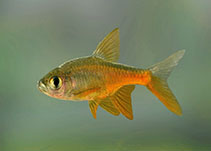| Family: |
Danionidae (Danios), subfamily: Rasborinae |
| Max. size: |
3.55 cm SL (male/unsexed) |
| Environment: |
benthopelagic; freshwater |
| Distribution: |
Asia: Kalu River, Bentara River, Gin River, Polathu-Modera River, and Nilwala River in Sri Lanka. |
| Diagnosis: |
Dorsal soft rays (total): 10-10; Anal soft rays: 9-9; Vertebrae: 28-29. Rasboroides pallidus differs from R. vaterifloris and R. nigromarginatus by having dorsal-fin origin 3 (vs. 1) scale-widths behind pelvic-fin origin and body depth of 34.3-37.5 % SL in males, 33.0-36.7 in females (vs. 31.1-32.8 in males and 31.0-31.7 in females of R. vaterifloris, and 28.2-33.0 in males and 26.9-29.1 in females of R. nigromarginatus). It can be differentiated from male R. rohani by having a smaller size of up to 24.6 mm SL (vs. up to 35.5 mm SL), having 1/2 6 1/2 or 1/2 7 1/2 (vs. 1/2 8 1/2) scales in transverse line on body, 20-24 (vs. 25-28) scales in lateral series on body, and 2 (vs. 1) lateral processes to the kinethmoid. Female R. pallidus differs from female R. rohani by possessing a greater eye diameter (39-40 % HL, vs. 29-34) and a greater interorbital width (33-36 % HL, vs. 25- 28) (Ref. 94541). |
| Biology: |
Found in shallow, slow-flowing, densely shaded lowland rain-forested streams with a sandy-silt
substrate (Ref. 94541). |
| IUCN Red List Status: |
Endangered (EN); Date assessed: 05 August 2019 (B1ab(iii)+2ab(iii)) Ref. (130435)
|
| Threat to humans: |
harmless |
Source and more info: www.fishbase.org. For personal, classroom, and other internal use only. Not for publication.

